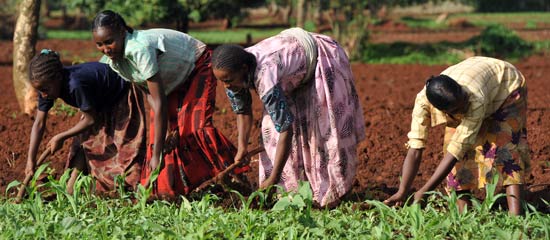Why MAIZE

Together with rice and wheat, maize provides at least 30 percent of the food calories of more than 4.5 billion people in 94 developing countries. Maize is often consumed indirectly in the form of eggs, corn syrup, milk and cheese products, beef and pork, but is commonly a staple food in developing countries, providing food for 900 million people earning less than US $2 per day.
Higher demand for maize, lower yields expected
Today, maize is the most important food crop in Sub-Saharan Africa and Latin America, and is a key Asian crop. In Sub-Saharan Africa, maize is consumed by 50 percent of the population and is the preferred food for one-third of all malnourished children and 900 million poor people worldwide. As the world’s population increases and more people begin to include higher amounts of meat, poultry and dairy into their diets, demand for maize is expected to rise. By 2025, maize will be the developing world’s largest crop and between now and 2050 the demand for maize in the developing world is expected to double.
However, while consumption is expected to increase two-fold, yields are expected to decline – leading to higher global prices and malnutrition, poverty and hunger for those whose diets are heavily dependent on maize.
Across the maize-producing regions of Asia, Sub-Saharan Africa and Latin America the effects of climate change will be felt unevenly, in some cases causing catastrophic loss of yields due to heat stress or introducing novel challenges such as disease. This will stretch the ability of local and regional agricultural systems to cope, and produce great hardships for those farmers that are not given the support they need to adapt. Yield penalties are predicted to be especially strong in tropical and sub-tropical areas, affecting well over 90 percent of resource-poor maize farmers and consumers.
Two thirds of studies predict overall yield declines of over 10 percent by 2050, meaning that developing countries would have to increase maize imports by 24 percent at an annual cost of US $30 billion. In China, over 30.2 million hectares of prime agricultural land is dedicated to maize production. But even this is not enough. In 2011 China became a net importer of maize for the first time in 14 years and by 2015, China is expected to import 15 million tons of maize from the US alone. In 2010, Indonesia imported 1.6 million tons of maize and it is estimated that Indonesia imported 3.2 million tons in 2012. Japan – the world’s largest importer of maize – imports an estimated 16 million tons of maize annually.
By 2050, global maize consumption is expected to increase from 32 to 52 kilograms per person per year. For industrialized countries, maize shortages and declining yields mean increased prices. However, for developing countries, maize shortages result in increased malnutrition for children, higher rates of poverty for smallholder farmers and extended periods of hunger for families.
A valuable feed grain
Maize, either grain or silage, is a reference feed around the world, endorsed by animal farmers for 30 years. Positive nutritional and economic features (easy to grow, harvest and store) have made it a competitive product, which has helped lower the price of food staples such as meat and dairy products. Rapid increases in poultry consumption in Africa and developing countries is a major factor contributing to the increased use of maize for livestock feed.
Maize is the world’s number one feed grain, including the developing countries. It is used extensively as the main source of calories in animal feed and feed formulation. Maize gives the highest conversion of dry substance to meat, milk and eggs compared to other cereal grains, and is among the highest in net energy content and lowest in protein and fiber content. Animals like and eat it readily. Studies have shown that it is possible to breed maize fit for both human and animal consumption without compromising on traits such as yield.
Biofuels: potential opportunities
Prices for maize, wheat, rice and soybeans tripled between 2006 and 2008 as demand for grains to be used for fuel increased. The Food and Agriculture Organization (FAO) of the United Nations recognizes the potential opportunities that the growing biofuel market offers to small farmers and aquaculturers around the world and has recommended small-scale financing to help farmers in poor countries produce local biofuel.
However increased biofuel production is also criticized for its potential impact on food availability, as it is feared that rising demand for crop land will cause deforestation and grassland conversion. FAO statistics on crop production and land use in the period 2000 to 2010 show that the impact of biofuel expansion on land use has been limited. Other sources have caused more (and more permanent) loss of agricultural area, such as urbanization, infrastructure development, as well as tourism and even nature development. (Biofuel expansion and land use change, Biomass Research Report, Wageningen, July 2013)
Learn more about the Challenges and Opportunities for MAIZE
Learn about what we do in MAIZE Impacts
